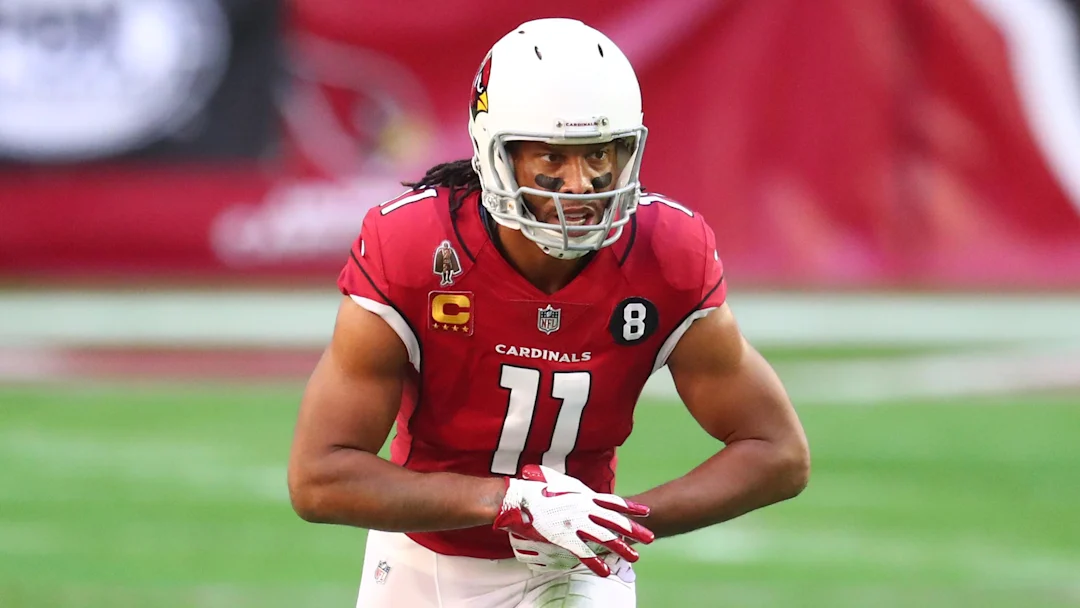Larry Fitzgerald is not just a football player. He’s not just a future Hall of Famer, either. He is, quite simply, the beating heart of the Arizona Cardinals franchise. For over 17 seasons, Fitzgerald carried the weight of an organization on his shoulders with class, loyalty, and brilliance that transcended the stat sheets. In a league filled with divas, trade demands, and flashy personalities, Fitzgerald was the anomaly—steadfast, humble, and relentless. He is Arizona’s greatest sports icon and one of the most universally respected athletes in NFL history. It’s long past time for the Cardinals to honor their greatest player with a permanent tribute: a statue outside State Farm Stadium.
Fitzgerald wasn’t just productive—he was transcendent. With over 17,000 career receiving yards, 121 touchdowns, and a staggering 1,432 receptions, Fitzgerald ranks among the greatest wide receivers to ever play the game. But numbers only scratch the surface of what he meant to Arizona. The Cardinals were often an afterthought in national conversations, a team stuck in the shadows of more glamorous franchises. But Fitzgerald changed that. He gave the Cardinals relevance. He gave them pride. And he gave fans in the desert a reason to believe, week in and week out.
What makes Fitzgerald’s case even more compelling is his loyalty. In an era where stars change teams chasing rings or contracts, Fitzgerald stayed. He remained loyal to Arizona even when the team struggled, even when playoff hopes faded, even when the quarterback carousel seemed never-ending. He stayed through it all, embodying the type of consistency and dedication that modern athletes rarely exhibit. That kind of loyalty is not just admirable—it’s statue-worthy.
There’s also the matter of leadership. Fitzgerald was the consummate teammate, respected not just for his talent, but for the way he elevated those around him. He led not through fiery speeches or dramatic outbursts, but by example. He was the first to arrive, the last to leave. He never complained. He never took plays off. And when things got tough, he stepped up. Who can forget his iconic 2008 playoff run? Fitzgerald was nearly unstoppable, making circus catch after circus catch, dragging defenders downfield and almost single-handedly leading the Cardinals to their first Super Bowl appearance in franchise history.
That Super Bowl XLIII performance alone could warrant a statue. In that game, Fitzgerald caught seven passes for 127 yards and two touchdowns, including what should have been the game-winning 64-yard score with just over two minutes left. Though the Cardinals ultimately fell short in heartbreaking fashion, Fitzgerald’s brilliance on the biggest stage was undeniable. He gave Arizona fans the most magical postseason ride in team history and cemented his place as a legend.
But Larry Fitzgerald’s legacy goes far beyond the field. He is one of the most respected ambassadors of the game. His work off the field is as impressive as his performance on it. Through the Larry Fitzgerald Foundation, he has raised millions of dollars to support breast cancer research, fund underprivileged youth programs, and promote education. His philanthropic efforts earned him the 2016 Walter Payton NFL Man of the Year Award, the league’s highest honor for community service and charity work.
He has also represented the Cardinals organization and the NFL on an international level with class and grace. Fitzgerald was never involved in controversy. He never made headlines for the wrong reasons. In fact, he often avoided the spotlight altogether. But when he spoke, people listened. When he acted, others followed. He became the gold standard for professionalism and excellence in the NFL.
Fitzgerald’s impact on Arizona extends well beyond football. In many ways, he helped put the Cardinals and the city of Phoenix on the national sports map. He embraced the community, giving back in countless ways, showing up at local events, and always making time for fans. He wasn’t just a star athlete—he was a role model, a leader, and a symbol of what sports can and should be about.
And in a state that doesn’t have a deep history of championship parades or major sports dynasties, Fitzgerald gave Arizona something to celebrate. He was the pride of the Valley, a constant source of hope and inspiration. Even fans of opposing teams respected him. That kind of universal admiration is rare, and it deserves permanent recognition.
When you look around the NFL, many teams have honored their legends with statues. The 49ers have one of Bill Walsh. The Cowboys have Tom Landry. The Bears have Walter Payton. The Broncos have Peyton Manning. All well-deserved, no question. But how can the Cardinals, after all these years, not have a statue of their greatest icon? Larry Fitzgerald wasn’t just the face of the franchise—he was the franchise.
Statues are not just about honoring greatness. They’re about telling stories. They’re about ensuring that future generations understand who helped build the foundation of an organization. Ten, twenty, fifty years from now, young fans should be able to walk into State Farm Stadium, see that bronze figure, and learn who Larry Fitzgerald was and what he meant. A statue is not just a tribute—it’s a history lesson cast in stone.
And for the Cardinals, there’s simply no one more deserving. Not a coach, not an owner, not another player. Fitzgerald stands alone. He holds nearly every franchise record. He redefined what it meant to be a Cardinal. He stayed loyal when few others would. He gave his entire career to one team, one city, and one fanbase. He never asked for much in return—only the chance to play the game he loved.
Even after his retirement, Fitzgerald continues to represent the organization with grace. Whether he’s doing television work, business ventures, or charity events, he always carries himself like a Cardinal. He hasn’t chased attention or demanded honors. That’s just not his style. But that humility only reinforces why he deserves a statue even more. Some players demand recognition. Fitzgerald earned it.
It’s not about inflating ego or celebrating fame. It’s about enshrining legacy. And Larry Fitzgerald’s legacy is larger than life. He didn’t just play football in Arizona—he became Arizona football. His fingerprints are on every great memory the Cardinals have given their fans over the past two decades. From toe-tapping touchdowns to fingertip grabs to playoff heroics, Fitzgerald gave Arizona everything he had.
And now, Arizona has a chance to give something back. A statue. A symbol. A lasting monument to a man who gave so much and asked for so little. It should rise tall and proud, greeting fans as they enter the stadium he helped define. It should capture the essence of his iconic stride, perhaps mid-route, hands extended, eyes locked on the ball—poised, focused, and fearless.
Because that’s who Larry Fitzgerald was. Reliable. Clutch. Brilliant. And beloved.
The Arizona Cardinals have had legends. They’ve had stars. But they’ve only had one Larry Fitzgerald. He’s more than a football icon—he’s a cultural pillar, a living legacy, and a reminder of what loyalty, integrity, and greatness truly look like.
Erecting a statue isn’t just a feel-good gesture. It’s the right thing to do. It’s the necessary thing to do. And it’s long overdue. Let the world know that Arizona remembers and honors its heroes. Let the statue of Larry Fitzgerald rise, not just in bronze, but in the hearts of Cardinals fans forever.
Because legends never fade—and Fitzgerald’s legacy deserves to stand tall for generations to come.



